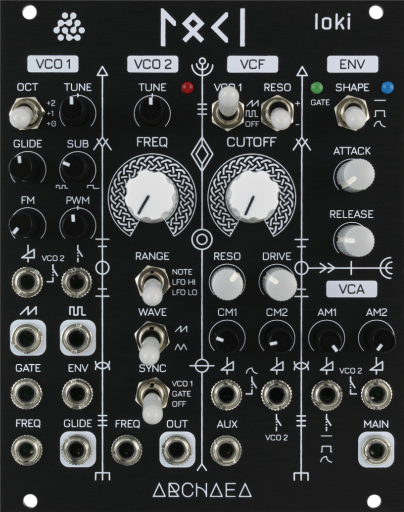Loki Eurorack Analog Mono-Synth

Loki is a dual oscillator analog mono-synth module measuring just 20HP. It gives a complete analog synth voice with a warm, full and raw sound to your rack. A great way to start in modular or a way of freeing up many of your existing analog modules.
Loki provides a complete analog synth voice for your modular rig with its FatkeysTM SSI2144 filter*. It’s an analog workhorse – freeing up your other analog modules for the most complex tasks. It is semi-modular, its sound can be expanded using the 16 jack sockets. Or, it can be used as a standalone desktop synth in a powered skiff, for example, the 4MS Pod20.
Loki has multiple modulation inputs and options, including an LFO mode, hard-sync, AM, FM, PWM, and VCF modulation and key tracking. It can provide a wide range of ‘acid’ sounds using its glide, envelope CV (accent), sub-oscillator, overdrive, dual-mode resonance, and second oscillator.
Loki is a straightforward way to start building a modular system, add another complete synth voice to a bigger system or even achieve analog polyphony or ensemble voices by stacking more than one together.
Features
- Oscillator one: saw, and pulse outputs, glide, PWM, FM, sub-oscillator
- Oscillator two: saw and triangle outputs, LFO, hard-sync, sync to gate
- Filter: SSI2144 based design, two modulation inputs, aux input, drive
- Envelope generator: drone, window and attack-release, level input
- Amplifier: two modulation inputs
- Default signal path and 16 patch connections
Specifications
- Width: 20HP
- Height: 3U (Eurorack)
- Depth: 32mm (including power connector)
- Current: 12V: 93mA, -12V: 79mA, 5V: 6.4mA
- Assembly: Fully assembled and tested OR medium-complexity kit
Demos have been produced by Remote Vision (Don Tyler of Synphaera), Isostatic (Sean Costello) and Archaea where indicated. See the track descriptions on Soundcloud for notes about the production process.
Music from the Loki walkthrough demo video by The Unperson, without voice over. All music produced by The Unperson using the Archaea Loki synthesizer as the lead sound accompanied with drum samples and incidental effects. Produced with external effects processing.
L.A. based electronic music producer and Grammy-nominated mastering engineer Don Tyler (Remote Vision) has this to say about Loki:
“What a beautiful voice! And versatile. The Loki excels at a deep analog ambient vibe, with a hint of 70’s German psychedelia and 101-ish acid! It’s become the go-to analog voice in my system. It sounds vintage, yet it’s very stable. I love it.“
Ben Chilton (Life is Feedback) of Elevator Sound says:
“Thick, rich and snarling in all the right ways!”
The Unperson says this about Loki:
“It has definitely got its own unique character and it can do classic and experimental, which is exactly what I want from a mono synth.”
The voltage controlled filter is based around the analog FatkeysTM SSI2144 filter chip*, an updated version of the SSM2044 4-pole low-pass filter used in numerous classic synthesizer designs. The filter design features a resonance path external to the 4 low-pass cores of the SSI2144. This allows resonance to be optionally added to the low-pass response without loss of bass. The filter output is smoothly managed by a custom- designed drive circuit that allows an adjustable amount of punch to be added to the sound.
The second oscillator frequency, filter cutoff and other main controls are provided with larger knobs for live performance. 16 patch connections are provided which are organised by sub-module as an easy cue to their function. The sockets are located towards the bottom of each sub-module to keep cables away from the controls. Loki is simple enough to be patched live, but with enough connections to allow it to be used live or in the studio with a sequencer.
*Fatkeys is a trademark of Sound Semiconductor.
LOKI FILTER RESONANCE MODES
Loki has two filter modes which give the filter two types of resonant sounds.
Negative Resonance Mode
In the ‘negative resonance’ mode, the low-pass frequency response is subtracted from the resonant peak level. This mode keeps the signal peaks within the same range as the response without resonance. This will give the minimum amount of drive at the filter output as the peaks will not exceed the overdrive limit, giving the purest resonant tone similar to the sound of classic ‘ladder’ filter designs. However the bass response of the filter will be reduced as the resonance is increased.

Positive Resonance Mode
In the ‘positive resonance’ mode, the resonant peak is added to the low-pass response. This mode maintains the bass response of the filter, and pushes the resonant peak into the output overdrive, which increases the harmonics of the resonance oscillation. This gives a thick resonant, full-bass sound.






